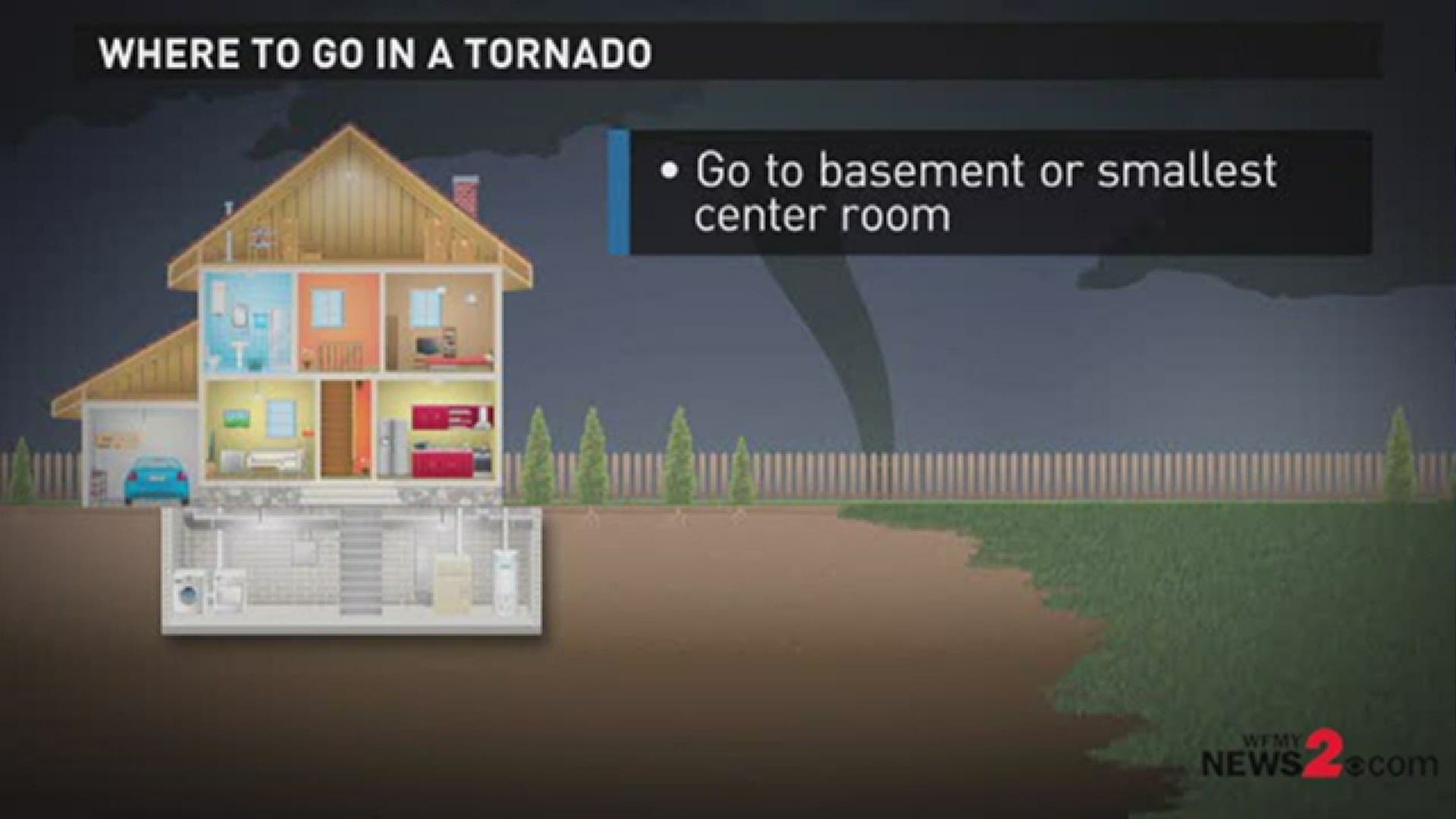GREENSBORO, N.C. — The National Weather Service will issue either a Severe Thunderstorm Watch/Warning or a Tornado Watch/Warning. It's important to know the difference so you can stay weather-aware.
North Carolina experiences about 40 to 50 thunderstorm days per year on average. About 10 percent of thunderstorms are classified as severe storms, which means that the storms can produce at least 1" hail, has 58+ mph winds, or a tornado.
SEVERE THUNDERSTORM WATCH/WARNING
Know the difference between a Severe Thunderstorm WATCH and a WARNING:
- A WATCH means severe weather is possible, but not yet happening. Keep checking up on the weather throughout the day, have a plan ready in case warnings are issued for your area.
- A WARNING means severe weather is happening in your area. Seek shelter, and get to a safe place.
TORNADO WATCH/WARNING
Know the difference between a Tornado WATCH and a WARNING:
- A TORNADO WATCH means conditions are favorable for severe weather or a tornado to develop. People located in and around the watch area should keep an eye toward the sky and listen to their NOAA weather radio or tune to WFMY News 2 for further weather information. The watch is intended to give you time to prepare and review your safety rules.
- A TORNADO WARNING means that a tornado has been detected by the National Weather Service Doppler radar or a reliable report of a tornado has been reported from the field. A tornado warning is usually issued for portions of one or two counties for an hour or less. The storm could also produce large hail and destructive straight-line winds. If the tornado warning includes your neighborhood or workplace, you should seek safe shelter immediately.
SEEK SHELTER
When your area is under a tornado warning, or if you see a tornado approaching, you should seek shelter immediately! Most injuries associated with high winds are from flying debris, so remember to protect your head, even wearing a helmet and shoes in your safe spot is a good idea. The following are safety tips for seeking shelter during high winds and tornadoes.
Here are some tornado safety tips:
- In general, get as low as you can. A basement below ground level or the lowest floor of a building offers the greatest safety.
- Put as many walls between yourself and the outside as possible. Avoid windows at all costs!
- Tornadoes could be obscured by rainfall or come in the overnight hours. Do not wait until you see or hear the tornado, it may be too late.
- Do not waste time opening or closing windows and doors. It will not protect the structure. You will only waste time and put yourself and others at greater risk. Use those valuable seconds to find a place of safety.
If you are in a structure such as a residence, small building, school, nursing home, hospital, factory, shopping center, or high-rise building:
- Go to a pre-designated area such as a safe room, basement, storm cellar, or the lowest building level. If there is no basement, go to the center of a small interior room on the lowest level (such as a closet, bathroom, or interior hallway) away from corners, windows, doors, and outside walls. Put as many walls as possible between you and the outside. Get under a sturdy table and use your arms to protect your head and neck.
- In a high-rise building, go to a small interior room or hallway on the lowest floor possible.
- Do not open windows.
HOME SAFETY
In homes or public buildings go to the basement or a small interior room such as a closet, bathroom or an interior hall on the lowest level. Close all doors to the hallway for greater protection. If possible, get under something sturdy like a heavy table. Protect yourself from flying debris with pillows, heavy coats, blankets, or quilts. Use bicycle or motorcycle helmets to protect your head.
MOBILE HOME
If you are inside a mobile home, leave well in advance of the approaching severe weather and go to a strong building. If there is no shelter nearby, get into the nearest ditch, low spot or underground culvert. Lay flat, covering your head with your hands for protection.
VEHICLE
If you are in a vehicle or outdoors when tornadoes are possible, limit your outdoor plans or finish them early.
OUTSIDE
Stay close to a sturdy shelter. If caught outside, find shelter in a ditch or remain in your vehicle and cover your head for protection. Do not take shelter under a highway overpass, where wind speeds can increase due to a tunneling effect. It is best not to put yourself or others in a situation where no sturdy shelter is available.
HOW TORNADOES FORM
Tornadoes are spawned from strong, severe thunderstorms and can cause fatalities and devastate a neighborhood in seconds. A tornado appears as a rotating, funnel-shaped cloud that extends from a thunderstorm to the ground with whirling winds that can reach 300 miles per hour, in the strongest ones. Some tornadoes are clearly visible, while rain or nearby low-hanging clouds can obscure others. In some instances, tornadoes can develop so rapidly that little, if any, advance warning is possible, making them even more dangerous.

